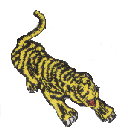The Ed Parker Patch
About the Parker Kenpo Patch

The Tiger
Represents earthy strength derived during the early stages of
learning. This is the stage where the individual is impressed
with his own physical prowess.
The Dragon
Represents spirtual stength which comes with seasoning. This
mental attitude is attained during the indiviual's later years
of training. It is placed above earthly stength (as indicated
and observed on the patch) since the individual at this stage
has learned to develop humility and self-restraint.
The attitude of the Dragon is the ultimate goal of Kenpo. Armed with
this attitude an individual will not be afraid of the opponent but of
what he can do to the opponent. Thus he turns back and walks away
from an unwarranted conflict confident that he could have been the
victor.
The Circle
The circle is symbolic of several things:
- It depicts life itself, a continuous cycle where there is neither
beginning nor end. So is the art of Kenpo, a cycle of perpetual
and unending movement or motion. Techniques follow a cycle,
movements are part of a cycle, physical prowess, humility and
self-restraint are no more than components of a progressive
learning cycle.
- All moves evolve from a circle whether they are defensive
or offensive.
- The circle represents the bond of friendship that should
continuously exist among Kenpo practitioners.
- The circle is the base from which our Alphabet of Motion stems.
The Dividing Lines
The dividing lines in the circle represent:
- The original eighteen hand movements, directions in which
the hands can travel.
- The angles from which you or an opponent can attack or defend.
- The pattern in which the feet can move.
The Colors
The various colors represent proficiency, achievement and authority.
The circle is Gray, symbolic of the brain (as in "gray matter").
The White background is significant of the many beginners who form
the base of the Art.
Yellow & Orange represent the first level of proficiency, the
mechanical stage; the dangerous stage in learning where the
student is more impressed with the physical, who thinks he knows all
of the answers.
Brown, the color of the Tiger's eyes, represents the advance
students, though not great in number. At this level the student
becomes more observant. His eyes, like that of the Tiger, are keen,
ever so watchful and critical, always looking up to the higher levels
of preficiency, striving for perfection, preparing for the day he
beares the label of an expert.
Black represents the level of expert proficiency.
Red is that of professorship over and above Black. But, as
indicated by the colors of the Dragon, there are still traces of
White in the his eye, Yellow and Orange on the his fins, Brown in the
iris of his eye, and Black in the pupils of his eye. This is to remind
the Professor that he too should always be humble and able to go back
to any level, whatever it might be, and perform the things that he
expects of others at these levels so as never to demand too much of
his students.
The Oriental Writing
This is a reminder of the originators of our Art, the Chinese.
It is in respect to them, but not that we serve them.
The lettering on the left it means Spirit of the Dragon and the
Tiger, a constant reminder that we want to attain the spiritual
level and and that the physical level is only a stepping stone or
vehicle, that we used to reach the higher or spiritual level.
The lettering to the right means Kenpo Karate; Law of the Fist and
the Empty Hand.
The Shape
The top of the crest of the patch is like a roof which gives
shelter to all who are under it.
The sides are curved conversely because like the roof of a Chinese
home it is to send evil back to where it came from, whenever it tries
to descend.
The bottom forms the shape of an ax, representing the excecutioner.

Home •
Basics •
Techniques •
Forms & Sets •
Terms •
Kenpo Sites
Notes •
Grappling •
Sticks/Knives




